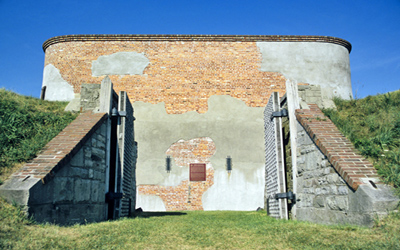Fort Mississauga National Historic Site of Canada
Niagara-on-the-Lake, Ontario

General view
© Parks Canada Agency / Agence Parcs Canada.
Address :
223 Queen Street, Niagara-on-the-Lake, Ontario
Recognition Statute:
Historic Sites and Monuments Act (R.S.C., 1985, c. H-4)
Designation Date:
1960-05-30
Dates:
-
1814 to 1840
(Construction)
Other Name(s):
-
Fort Mississauga
(Designation Name)
-
Niagara National Historic Sites of Canada
(Other Name)
Research Report Number:
1960-15
DFRP Number:
10398 00
Plaque(s)
Existing plaque: Mounted in front of main entrance 223 Queen Street, Niagara-on-the-Lake, Ontario
This tower and earthwork are all that survive of the barracks, guardroom, and cells of Fort Mississauga. Built between 1814 and 1816 to replace Fort George as the counterpoise to the American Fort Niagara immediately opposite, it was garrisoned until 1826. Repaired and rearmed following the Rebellion of 1837, it continued to be maintained until 1854 in response to border disputes with the United States. It was manned during the tense years of the American Civil War and the Fenian scare of 1866, but by 1870 it was no longer considered of military value.
Description of Historic Place
Fort Mississauga is a large, square, brick defensive tower set within the remains of earthworks on the shoreline of the Niagara River. On the landward side, it is surrounded by golfing greens located within the town of Niagara-on-the-Lake.
Heritage Value
Fort Mississauga was declared a national historic site because: it is an important example of military construction within a military complex of national historic importance, completed after the War of 1812, the fort and its central tower were located in a strategic position at the mouth of the Niagara River to protect the British/Canadian side of the frontier and to serve as a counterpoise to Fort Niagara on the American side, it is the only remaining example in Canada of its type of fortification - a square tower within a star-shaped earthwork.
The heritage value of Fort Mississauga lies in its illustration of a rare type of military structure located in a strategic position.
Sources: Historic Sites and Monuments Board of Canada, Minutes, May 1960, October 1963, June 1994; Commemorative Integrity Statement.
Character-Defining Elements
Key features contributing to the heritage value of this site include:
the strategic location beside the lake at the mouth of the Niagara River, the square massing of the tower, the outline (both profile and footprint), and composition of the star-shaped earthwork, the defensive design elements of the tower such as the smooth non-combustible walls, elevated entry and fireproof roofing, the brick construction materials and skilled craftsmanship of the tower, the volume of the powder magazine and its bomb and fire-proof construction, the remains of casemates, and built landscape features including the earthworks with its glacis, ravelin, gate and sallyport, the spatial and functional relationships between the tower and earthworks, the archaeological remains of other structures such as the footprint and remnants of former buildings within the fort earthworks and the 1804 lighthouse and lightkeeper's residence, the viewplanes to the mouth of the Niagara River and to Fort Niagara.